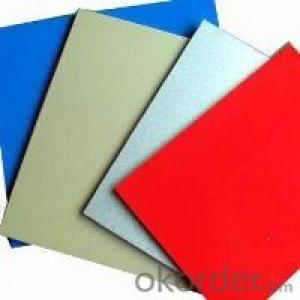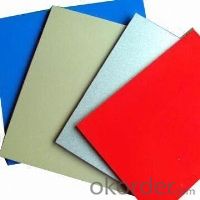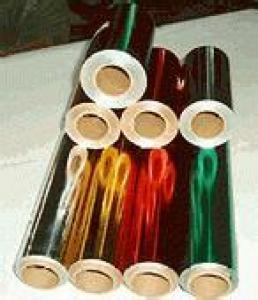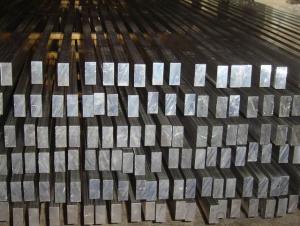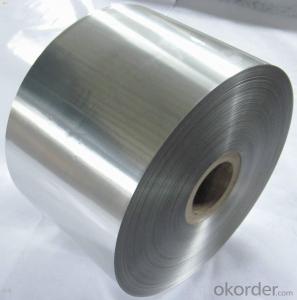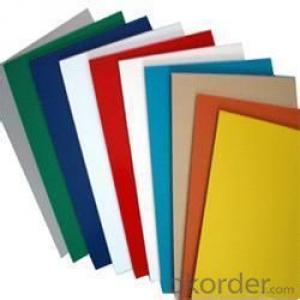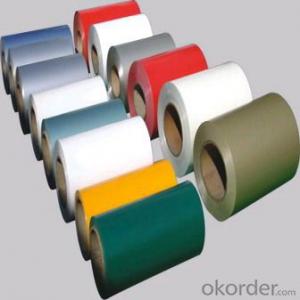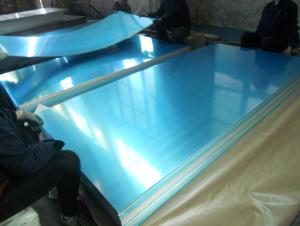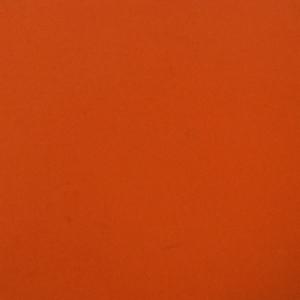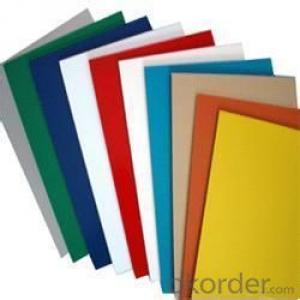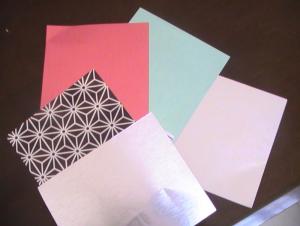Prepainted Aluminum Sheet
- Loading Port:
- China Main Port
- Payment Terms:
- TT OR LC
- Min Order Qty:
- -
- Supply Capability:
- -
OKorder Service Pledge
OKorder Financial Service
You Might Also Like
Aluminium foil acts as a total barrier to light and oxygen (which cause fats to oxidise or become rancid), odours and flavours, moistness, and germs, it is used broadly in food and pharmaceutical packaging. The purpose of aluminium is to make long-life packs (aseptic processing|aseptic packaging) for drinks and dairy goods, which allows storing without refrigeration. Aluminium foil containers and trays are used to bake pies and to pack takeaway meals, ready snacks and long life pet foods.
Aluminium foil is widely sold into the consumer market, often in rolls of 500 mm (20 in) width and several metres in length.It is used for wrapping food in order to preserve it, for example, when storing leftover food in a refrigerator (where it serves the additional purpose of preventing odour exchange), when taking sandwiches on a journey, or when selling some kinds of take-away or fast food. Tex-Mex restaurants in the United States, for example, typically provide take-away burritos wrapped in aluminium foil.
Aluminium foils thicker than 25 μm (1 mil) are impermeable to oxygen and water. Foils thinner than this become slightly permeable due to minute pinholes caused by the production process.
Aluminium foil has a shiny side and a matte side. The shiny side is produced when the aluminium is rolled during the final pass. It is difficult to produce rollers with a gap fine enough to cope with the foil gauge, therefore, for the final pass, two sheets are rolled at the same time, doubling the thickness of the gauge at entry to the rollers. When the sheets are later separated, the inside surface is dull, and the outside surface is shiny. This difference in the finish has led to the perception that favouring a side has an effect when cooking. While many believe that the different properties keep heat out when wrapped with the shiny finish facing out, and keep heat in with the shiny finish facing inwards, the actual difference is imperceptible without instrumentation.The reflectivity of bright aluminium foil is 88% while dull embossed foil is about 80%.
We provide a full range of precision aluminum strip for almost any application. We produce aluminum strip in a wide variety of alloys, including clad composites. Our aluminum strip can be produced in standard dimensions or custom made to your special requirements. We produce both imperial and metric units. We manufacture in compliance with the main international specifications, and tighter tolerances or custom tempers are available upon request. We offer various surface conditions, custom finishes (painting, anodizing, embossing), special processing, and multiple packaging options to meet our customer's unique requirements. The following is a summary of our capabilities.
Manufactured in compliance with the main international specifications and standards, including: Aluminum Association, ASTM, EN, and DIN.
We can also manufacture in compliance with other international standards including:ASME, SAE, AMS, AWS, FED, MIL, QQ, ISO, BS, AFNOR, JIS and GOST.
Manufactured in compliance with the main international specifications and standards.
Tighter tolerances are available upon request.
Aluminium (or aluminum; see spelling differences) is a chemical element in the boron group with symbol Al and atomic number 13. It is a silvery white, soft, ductile metal. Aluminium is the third most abundant element (after oxygen and silicon), and the most abundant metal in the Earth's crust. It makes up about 8% by weight of the Earth's solid surface. Aluminium metal is so chemically reactive that native specimens are rare and limited to extreme reducing environments. Instead, it is found combined in over 270 different minerals.The chief ore of aluminium is bauxite.
Aluminium is remarkable for the metal's low density and for its ability to resist corrosion due to the phenomenon of passivation. Structural components made from aluminium and its alloys are vital to the aerospace industry and are important in other areas of transportation and structural materials. The most useful compounds of aluminium, at least on a weight basis, are the oxides and sulfates.
Despite its prevalence in the environment, no known form of life uses aluminium salts metabolically. In keeping with its pervasiveness, aluminium is well tolerated by plants and animals. Owing to their prevalence, potential beneficial (or otherwise) biological roles of aluminium compounds are of continuing interest.
The earliest citation given in the Oxford English Dictionary for any word used as a name for this element is alumium, which British chemist and inventor Humphry Davy employed in 1808 for the metal he was trying to isolate electrolytically from the mineral alumina. The citation is from the journal Philosophical Transactions of the Royal Society of London: "Had I been so fortunate as to have obtained more certain evidences on this subject, and to have procured the metallic substances I was in search of, I should have proposed for them the names of silicium, alumium, zirconium, and glucium."
Davy settled on aluminum by the time he published his 1812 book Chemical Philosophy: "This substance appears to contain a peculiar metal, but as yet Aluminum has not been obtained in a perfectly free state, though alloys of it with other metalline substances have been procured sufficiently distinct to indicate the probable nature of alumina."[69] But the same year, an anonymous contributor to the Quarterly Review, a British political-literary journal, in a review of Davy's book, objected to aluminum and proposed the name aluminium, "for so we shall take the liberty of writing the word, in preference to aluminum, which has a less classical sound."
The -ium suffix conformed to the precedent set in other newly discovered elements of the time: potassium, sodium, magnesium, calcium, and strontium (all of which Davy isolated himself). Nevertheless, -um spellings for elements were not unknown at the time, as for example platinum, known to Europeans since the 16th century, molybdenum, discovered in 1778, and tantalum, discovered in 1802. The -um suffix is consistent with the universal spelling alumina for the oxide (as opposed to aluminia), as lanthana is the oxide of lanthanum, and magnesia, ceria, and thoria are the oxides of magnesium, cerium, and thorium respectively.
The aluminum spelling is used in the Webster's Dictionary of 1828. In his advertising handbill for his new electrolytic method of producing the metal in 1892, Charles Martin Hall used the -um spelling, despite his constant use of the -ium spelling in all the patents[58] he filed between 1886 and 1903. It has consequently been suggested[by whom?] that the spelling reflects an easier-to-pronounce word with one fewer syllable, or that the spelling on the flyer was a mistake.[citation needed] Hall's domination of production of the metal ensured that aluminum became the standard English spelling in North America.
- Q: what is aircraft grade aluminum?
- Aircraft grade Aluminum is made to be very durable and strong, also Aluminum does not rust.
- Q: I can't seem to find what uses or contains Aluminum Nitride. Help!
- Don't know where you looked, but this came up with very basic web search. Metallization methods are available to allow Aluminium nitride to be used in electronics applications similar to those of alumina and beryllium oxide. Among the applications of Aluminium nitride are opto-electronics, dielectric layers in optical storage media, electronic substrates, chip carriers where high thermal conductivity is essential, military applications, as a crucible to grow crystals of gallium arsenide, steel and semiconductor manufacturing. Epitaxially grown thin film crystalline aluminium nitride is also used for surface acoustic wave sensors (SAW's) deposited on silicon wafers because of the Aluminium nitride's piezoelectric properties. One application is an RF filter used in mobile phones called a thin film bulk acoustic resonator (FBAR). This is a MEMS device that uses aluminium nitride sandwiched between two metal layers.
- Q: Why does aluminum foil float even though it has a greater density than the water itself? Im sure every 1 will say bouincy but pleaseeee dont there must be soemthing ealse affecting this.like maybe a property that water has? If any one find an answer to this question and replays could you please add the site you got the information from, ty
- Maybe the slightest bit of air always gets trapped and it aids in the buoyancy? I am pretty sure that the science experiment I did says that if you make sure that there is no air under a perfectly flat piece of foil, it will sinkHowever, if you roll it in a ball it will floatthis is because the air is caught in so many places on the ball which feels spikeythat is why it floatsDensity works only if you ball up the aluminumotherwise the density is higher as a flat sheet.
- Q: Nokia N8, 700, Sony Ericksson Xperia Ray, Samsung Galaxy W or Ace, HTC Salsa or Explorer, Blackberry Curve 9360 or 9380Any help greatly appreciated.
- nokia n8: with its excellent package of features, free firmware updates til atleast 2016, free lifetime navigation, anodised aluminium casing and gorilla glass screen, its a great investment.
- Q: I know you're not suppose to have metal in thereI once saw a mini lightnening storm when I accidently left a fork on the plateAnother time I warmed up a Wendy's burger on it's aluminum foil wrapper and again, lightening.But today, I warmed up some Chinese rice in the carton that it always comes inThe little handle on it is metal but there was no lightening storm inside the microwave at allI nuked the carton for two more minutes and nothing.the rice was warmed up effectively, thoughIs this still unsafe? Why didn't the microwave reject(affect) the metal handle?
- Microwaves are small radio waves about 4 inches longAs with any waves they can go through, reflect or be absorbedIn cooking in a microwave, they go through glass, paper, plastic, and are absorbedd by the water molecules in the foodHere they are converted into heatThey are reflected by metalSo they are reflected by the inside of the box and the doorThey are reflected by the fork, aluminum foil or metal cooking containerIf they are reflected back into the magnetron that generates the waves, it can damage the magnetronIs it dangerous?, No, but could ruin the microwaveOn cooking a turkey, it is recommended that you wrap foil around the tips of the legs so that they do not become overcooked.The handle on the Chinese food package is small enough so it is rarely hit, and then the waves are reflected around the metal boxIf you turn on the microwave with nothing in it to absorb the energy, it will create that lightning storm too.
- Q: Are there any restrictions on the export or import of aluminum coils?
- The export or import of aluminum coils is subject to restrictions that vary depending on the country and specific regulations in place. These restrictions encompass various measures such as export licenses, quotas, and tariffs. Export licenses are often necessary to comply with export control regulations, particularly for sensitive industries or countries. Quotas restrict the quantity of aluminum coils that can be exported or imported within a specific timeframe. Tariffs, on the other hand, involve taxes imposed on imported goods, impacting the cost and competitiveness of aluminum coils in the market. Furthermore, additional restrictions may be imposed concerning quality standards, environmental regulations, or trade agreements between countries. Therefore, it is crucial for individuals or businesses engaged in the export or import of aluminum coils to conduct thorough research and gain a comprehensive understanding of the specific restrictions within their respective jurisdictions. Seeking guidance from legal or trade experts can facilitate navigation through these restrictions and ensure compliance with applicable laws.
- Q: Sorry, random stupid questionBut I have deodorant that smells like baby powderIs it possible that all it is baby powder formed into a stick so someone could roll it on?
- Read the ingredient list on the packageI'm sure that it's more than just baby powderThere is probably something like Aluminum Chlorohydrate .
- Q: Rank each of the following in order of decreasing effective nuclear charge for its valence electrons? (Largest first ) Oxygen , fluorine , silicon , sodium , aluminum , beryllium
- silicon,aluminium,sodium,fluorine,oxygenthis is decreasing order of effective nuclear charge and thank you
- Q: Is there a good way to cook corn on the cob in the oven if you're out of aluminum foil?
- Peel the husk and remove the silkWrap the corn in continuous length paper towelsSplash water on the paper towel to dampen itPlace in microwave oven and cookYour microwave may have a Vegetables settingIf so, and if given the choice, select 'Hard, push start and the microwave will turn itself off when the corn is doneIf no Vegetables setting, try cooking for about two minutes on high power - experiment until you find the right timeRemove from Microwave - be careful - the corn will be very hotUnlike boiling, the corn will be firmer and have more taste.
- Q: Whether aluminum tape has conductivity of heat?
- aluminum tape usually don't stress conductivity of heat. General Cable using aluminum tape mainly consider its high temperature resistance and insulativity.
Send your message to us
Prepainted Aluminum Sheet
- Loading Port:
- China Main Port
- Payment Terms:
- TT OR LC
- Min Order Qty:
- -
- Supply Capability:
- -
OKorder Service Pledge
OKorder Financial Service
Similar products
Hot products
Hot Searches
Related keywords
